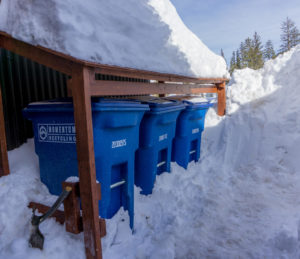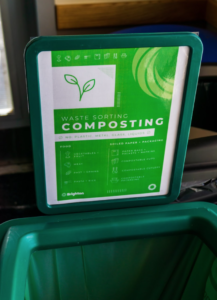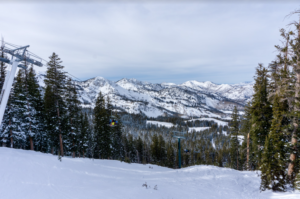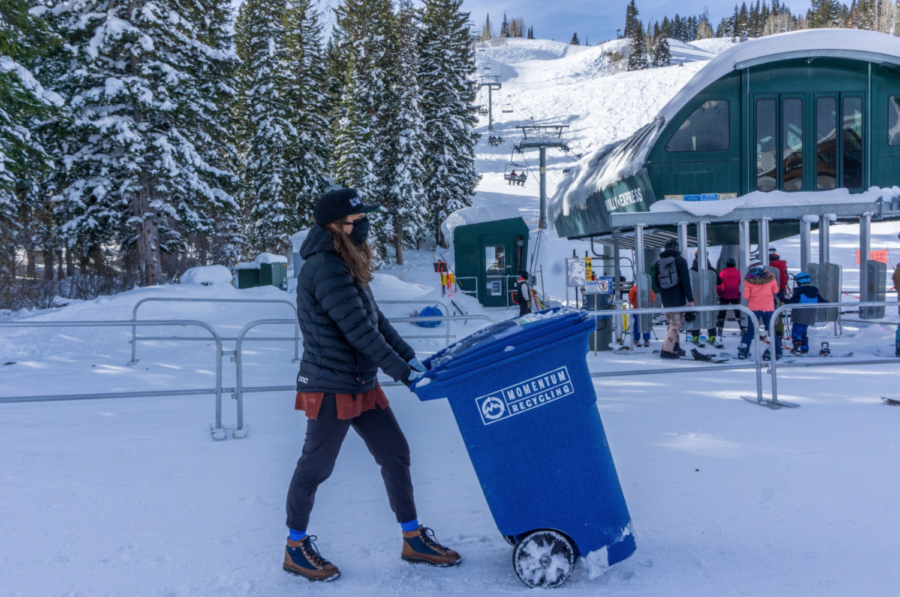Ski Resorts Turn to Composting to Lower Emissions
As you head to your favorite ski resorts this season, keep an eye out for something new popping up — composting bins.
This season, ski resorts across the country are implementing new composting programs, or revamping old composting programs, to help limit their carbon emissions.
The ski industry is a historically high emitting business. From infrastructure development to water use for snow production and gas usage for lifts, ski resorts require a lot of energy.
The industry has good reason to be concerned about carbon and climate change. A 2017 study published in Global Environmental Change found that the length of the ski season is expected to be cut in half by 2050, putting the entire $20 billion industry at risk.
To help lower their emissions, resorts are working to reduce food waste from being thrown in the trash. Diverting food waste from going to the landfill reduces methane and carbon emissions as well as creates nutrient-rich soils that lessen the need for fertilizers in agriculture. A study in Compost Science & Utilization found that a significant amount of methane is generated when food waste is sent to a landfill, but not when it is composted.
Brighton Ski Resort in Utah implemented a pilot composting program in 2021. Over three months, Brighton composted nearly 10,000 pounds of food waste. The pilot program composted waste from the kitchens and staff. This season, Brighton plans to expand the program to the public, but that won’t come without a struggle. Erika Kazi, the sustainability director at Brighton Resort, worries guests might not properly use the new waste containers. “People don’t think about their waste, they just throw things away,” Kazi said. “Out of sight, out of mind.” Part of Brighton’s goals for the coming ski season is to train employees on how to guide customers to use proper disposal procedures. The resort has installed signs to show which types of trash go in each bin.
Composting could reduce emissions from the resort, and it may also save Brighton money. Keeping food waste out of its trash saves the resort $35 a pound, according to Kazi. “Down the road, it will save us money, but it is going to take a decent amount of time to do that,” Kazi said.
Brighton is implementing composting as part of its commitment to having net zero emissions by 2030, a company-wide pledge across all Boyne Resorts, the parent company of Brighton.
 The National Ski Area Association (NSAA) has a program called Sustainable Slopes, which is a framework to help ski resorts green their operations across 10 different topic areas. One of the first areas a ski resort can focus on is waste reduction. “Waste reduction is kind of one of those low-hanging fruit projects that ski areas can engage in right at the beginning of their sustainability journey,” said Adrienne Isaac, the director of marketing and communication for the NSAA. Sustainable Slopes outlines a series of projects for resorts that target areas like energy reduction, water efficiency, transportation initiatives, education, advocacy, supply chain decarbonization, habitat health, and more.
The National Ski Area Association (NSAA) has a program called Sustainable Slopes, which is a framework to help ski resorts green their operations across 10 different topic areas. One of the first areas a ski resort can focus on is waste reduction. “Waste reduction is kind of one of those low-hanging fruit projects that ski areas can engage in right at the beginning of their sustainability journey,” said Adrienne Isaac, the director of marketing and communication for the NSAA. Sustainable Slopes outlines a series of projects for resorts that target areas like energy reduction, water efficiency, transportation initiatives, education, advocacy, supply chain decarbonization, habitat health, and more.
Ski resort initiatives go beyond just the resort, they affect the entire community according to Isaac. “Engaging your guests on even simple things like what they can do in their own home gets them engaged in climate action,” said Isaac. According to Isaac, the reason that ski resorts make these changes is to protect not just the future of snow sports, but the future of humanity at large.
Although composting only makes a minuscule dent in ski resort emissions, it is a good place to start. The NSAA makes it easy for resorts to know what projects to begin with and it helps them acknowledge and track their impacts.
Ski resorts historically have not thought about environmental degradation, and have been solely focused on revenue, but that is all starting to change.
Snowbird Ski Resort in Utah launched a pilot compost program in March 2021, with its neighbor resort Alta, who are both members of Sustainable Slopes. In the initial pilot program, the two resorts together collected a whopping 15,000 pounds of compost in six weeks. In June 2021, Snowbird began to expand its program and now Snowbird alone is collecting around 15,000 pounds each month. Snowbird is currently only doing back-of-house composting. The resort wants to dial in its internal composting systems before it opens it to the customers. “It’s going to take a big effort to make it guest-facing, so we want to do it slowly and with a solid education and signage program to accompany it,” said Hilary Arens, the director of sustainability and water resources at Snowbird.
Starting this season, Snowbird will be expanding composting into other facilities at the resort, including The Summit, a year-round guest facility located on the top of the mountain at 11,000 feet elevation.“One of our goals with composting at the resort is to engage our customers and convince them that if we can compost at 11,000 feet, even when it’s snowing, that hopefully they can also make changes at home and try composting,” said Arens.
Resorts outside of Utah are taking even bigger steps towards reducing landfill waste. Beginning in December, Snoqualmie in Washington, another Boyne-owned resort, is attempting to take composting to the next level by composting on-site, rather than having it hauled away. This reduces emissions from hauling and allows them to compost more. The resort is hoping to reduce its landfill waste by at least 20%, which is a huge feat.
Many of us don’t think about our environmental impact when we spend a day on the slopes, but it adds up. By implementing composting programs, ski areas are allowing their customers to play a role in making the industry a little bit greener. Although composting food scraps is in no way going to offset the impact of ski resorts, it is a jumping-off point, and it shows promise.
With a sport that is built solely on the health of the environment and winter conditions, it is imperative that resorts take every step possible to reduce their environmental impacts and engage the ski and snowboard community along the way.


